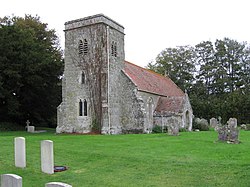Baverstock
| Baverstock | |
| Wiltshire | |
|---|---|
 St Editha's Church, Baverstock | |
| Location | |
| Grid reference: | SU028316 |
| Location: | 51°5’2"N, 1°57’40"W |
| Data | |
| Post town: | Salisbury |
| Postcode: | SP3 |
| Dialling code: | 01722 |
| Local Government | |
| Council: | Wiltshire |
| Parliamentary constituency: |
South West Wiltshire |
Baverstock is a small village and ancient parish in Wiltshire, about seven miles west of Salisbury. The village has 10 private dwellings, a church and several farm buildings. The manor of Hurdcott, a hamlet of a few houses, lies to the south-west of the village (not to be confused with Hurdcott near Winterbourne Earls).
To the north of the village is cultivated chalk downland and extensive mixed woodland. To the south the village is bordered by the River Nadder meandering through water meadows. The road through the village from the B3089 terminates in unmetalled farm track.
Baverstock is part of Dinton civil parish. Its own civil parish was reduced in size when its south-east part, including Hurdcott hamlet, was transferred to Barford St Martin in 1884; the whole of the civil parish was absorbed into Dinton in 1934.[1]
The Church of England parish church of Saint Edith is dedicated to the Wiltshire saint Edith of Wilton and stands on the brow of a slope facing south across the Nadder valley. The building is from the 14th and 15th centuries, with restoration in 1880–1893 by William Butterfield. The building is Grade-II* listed.[2] The tower has a ring of three bells, two of which date from the 15th century.[3] Today the church is part of the Nadder Valley team ministry.[4]
The churchyard contains, among others, the graves of 32 Australian soldiers from World War I. Soldiers were encamped locally before being transported to the war theatre in France. The majority died from infectious illness.
Baverstock Manor is a Grade II* listed house from the 16th century, with later alterations and 1930s restoration.[5] Close to the B3089 is the Penruddocke Arms, a public house named for the Penruddocke family who lived in neighbouring Compton Chamberlayne during the 18th and 19th centuries.
North of the village lies Baverstock Juniper Bank, a 6½-acre biological Site of Special Scientific Interest at SU035336.
References
- ↑ "Victoria County History: Wiltshire: Vol 8, Warminster, Westbury and Whorwellsdown Hundreds, pp25-34 – Dinton". University of London. http://www.british-history.ac.uk/vch/wilts/vol8/pp25-34.
- ↑ National Heritage List 1283631: Church of St Edith of Wilton
- ↑ "Baverstock, St Editha". http://dove.cccbr.org.uk/detail.php?DoveID=BAVERSTOCK.
- ↑ "St Mary, Dinton". https://www.achurchnearyou.com/dinton/.
- ↑ National Heritage List 1318738: Baverstock Manor
| ("Wikimedia Commons" has material about Baverstock) |
